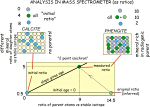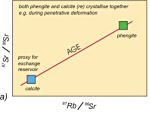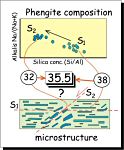Evolution of the metamorphic western Alps
Dating shear zones
Brief notes by Rob Butler.
 Gaining
reliable radiometric ages of deformation is key to many tectonic studies. But direct dating of shear
zones is difficult - simply because metamorphic rocks have complex histories and in many cases it is
not clear to which "event" in the life of a metamorphic rock the date relates. One approach
is to try to date the crystallisation of a mineral having established when that particular mineral grew
during the history of the rock within which it is contained. By examining the microstructure of rocks
it can be possible to establish whether mineral grains have recrystallised during deformation. So these
are good candidates for dating provided the isotopes being analysed have not diffused from the crystal
lattice after crystallisation. In practice this requires that the deformation occurred at temperatures
significantly below the closure temperature of the mineral/isotope system. For greenschist facies shear
zones (recrystallisation happening 300-400C say), there is a high probability that white mica (e.g.
phengite) will retain strontium isotopes from the time of the mineral crystallisation (the closure temperature
is c. 500C), and for the shear not to have warmed up subsequently. However, it is also necessary to
establish the ambient strontium isotopic composition that existed at the time of crystallisation (this
having been disturbed in the mica by the addition of more 87Sr by the decay of 87Rb – the decay
system that allows us to date the mica). This can be estimated using a mineral that crystallised
at the same time as the mica (i.e. during the deformation), which also retains the strontium since that
time and which has not been "contaminated" by further radiogenic strontium (i.e. has virtually
no rubidium in it). The feldspar albite is a good candidate except that this is a rheologically strong
mineral that can resist deformation (and therefore crystallisation). So calcite is the preferred mineral
to tie to with the mica.
Gaining
reliable radiometric ages of deformation is key to many tectonic studies. But direct dating of shear
zones is difficult - simply because metamorphic rocks have complex histories and in many cases it is
not clear to which "event" in the life of a metamorphic rock the date relates. One approach
is to try to date the crystallisation of a mineral having established when that particular mineral grew
during the history of the rock within which it is contained. By examining the microstructure of rocks
it can be possible to establish whether mineral grains have recrystallised during deformation. So these
are good candidates for dating provided the isotopes being analysed have not diffused from the crystal
lattice after crystallisation. In practice this requires that the deformation occurred at temperatures
significantly below the closure temperature of the mineral/isotope system. For greenschist facies shear
zones (recrystallisation happening 300-400C say), there is a high probability that white mica (e.g.
phengite) will retain strontium isotopes from the time of the mineral crystallisation (the closure temperature
is c. 500C), and for the shear not to have warmed up subsequently. However, it is also necessary to
establish the ambient strontium isotopic composition that existed at the time of crystallisation (this
having been disturbed in the mica by the addition of more 87Sr by the decay of 87Rb – the decay
system that allows us to date the mica). This can be estimated using a mineral that crystallised
at the same time as the mica (i.e. during the deformation), which also retains the strontium since that
time and which has not been "contaminated" by further radiogenic strontium (i.e. has virtually
no rubidium in it). The feldspar albite is a good candidate except that this is a rheologically strong
mineral that can resist deformation (and therefore crystallisation). So calcite is the preferred mineral
to tie to with the mica.  Using
isotopic analysis of both mica and calcite from the same strongly sheared rock has the potential of
yielding a "two-point" isochron that represents the crystallisation (and therefore deformation)
age. But there are pitfalls. One is that mica populations may be complex, with grains (or parts
of grains) inherited from an earlier part of the rock’s history. This will generate a mixed ages – older
than the true age of deformation. Another pitfall arises if the calcite (our proxy for the exchange
reservoir) is not fully recrystallised by the deformation. In the case of Tertiary orogens, the contamination
of the calcite population by inherited detrital clasts (with low 87/86 ratios) will give anomalously
old ages.
Using
isotopic analysis of both mica and calcite from the same strongly sheared rock has the potential of
yielding a "two-point" isochron that represents the crystallisation (and therefore deformation)
age. But there are pitfalls. One is that mica populations may be complex, with grains (or parts
of grains) inherited from an earlier part of the rock’s history. This will generate a mixed ages – older
than the true age of deformation. Another pitfall arises if the calcite (our proxy for the exchange
reservoir) is not fully recrystallised by the deformation. In the case of Tertiary orogens, the contamination
of the calcite population by inherited detrital clasts (with low 87/86 ratios) will give anomalously
old ages.
 A
good way of checking for mixed mica populations is to probe their microchemical composition. The alkali
to silica ratio increases as phengites crystallise down pressure. So if micas can be placed in the relative
order of their crystallisation, say using cross-cutting shear-band geometries, and the PT path of the
rock is know (e.g. it was down-pressure between the two fabric generations), a simple test is to examine
the phengite composition. The purity of bulk phengite populations can also be examined by analysing
sub-samples of the material being used for isotopic analysis. If the domains of different mica populations
are large enough it may be possible to select specific structural sites by micro-drilling, using the
samples to date specific parts of a rock (and hence of its history).
A
good way of checking for mixed mica populations is to probe their microchemical composition. The alkali
to silica ratio increases as phengites crystallise down pressure. So if micas can be placed in the relative
order of their crystallisation, say using cross-cutting shear-band geometries, and the PT path of the
rock is know (e.g. it was down-pressure between the two fabric generations), a simple test is to examine
the phengite composition. The purity of bulk phengite populations can also be examined by analysing
sub-samples of the material being used for isotopic analysis. If the domains of different mica populations
are large enough it may be possible to select specific structural sites by micro-drilling, using the
samples to date specific parts of a rock (and hence of its history).
For some applications of the methods – try the information on the Entrelor
shear zone and on Valtournenche,
both in the internal Western Alps.
For some basic information on radiometric dating why not check out the
dating part of the Dynamic Earth web site.
The team: This research angle involved the collaboration with Bob
Cliff, Simon Inger (now at Bath
University), Steve Freeman (now at RDR) and latterly Anna Biggs.
Some publications:
Butler, R.W.H. & Freeman, S. 1999. Dating Alpine shear zones - using Rb-Sr
geochronology on white mica to gain deformation ages in the western Alps.In: 3rd Workshop on Alpine
Geological Studies (ed. G. Gosso, F. Jadoul, M. Sella & M.I. Spalla) Memorie di
Scienze Geologiche, Padova, 51, 177-189.
Freeman, S., Inger, S., Butler, R.W.H. & Cliff, R.A. 1997. Dating deformation using Rb-Sr in
white mica; greenschist facies deformation ages from the Entrelor shear zone, Italian Alps. Tectonics 16,
57-76.
Freeman, S.R., Butler, R.W.H, Cliff, R.A., Inger, S., & Barnicoat, A.C. 1998. Deformation migration
in an orogen scale shear zone array ; An example from the Basal Brianconnais Thrust, Internal
Franco-Italian Alps. Geol. Mag. 135, 349-367.
Freeman, S.R., Butler, R.W.H., Cliff, R.A. & Rex, D.C. 1998. Direct
dating of mylonitic evolution: a multi-disciplinary geochronological study from the Moine thrust zone,
NW Scotland. J. Geol. Soc.
London 155, 745-758.
Reddy, S.M., Wheeler, J., Butler, R.W.H., Cliff, R.A., Freeman, S., Inger, S., Pickles, C., & Kelley,
S.P. 2003. Kinematic reworking and exhumation of the
convergent Alpine Orogen. Tectonophysics 365.
77-102.
|| Alpine Tectonics || Evolution of
the metamorphic western Alps ||
 Gaining
reliable radiometric ages of deformation is key to many tectonic studies. But direct dating of shear
zones is difficult - simply because metamorphic rocks have complex histories and in many cases it is
not clear to which "event" in the life of a metamorphic rock the date relates. One approach
is to try to date the crystallisation of a mineral having established when that particular mineral grew
during the history of the rock within which it is contained. By examining the microstructure of rocks
it can be possible to establish whether mineral grains have recrystallised during deformation. So these
are good candidates for dating provided the isotopes being analysed have not diffused from the crystal
lattice after crystallisation. In practice this requires that the deformation occurred at temperatures
significantly below the closure temperature of the mineral/isotope system. For greenschist facies shear
zones (recrystallisation happening 300-400C say), there is a high probability that white mica (e.g.
phengite) will retain strontium isotopes from the time of the mineral crystallisation (the closure temperature
is c. 500C), and for the shear not to have warmed up subsequently. However, it is also necessary to
establish the ambient strontium isotopic composition that existed at the time of crystallisation (this
having been disturbed in the mica by the addition of more 87Sr by the decay of 87Rb – the decay
system that allows us to date the mica). This can be estimated using a mineral that crystallised
at the same time as the mica (i.e. during the deformation), which also retains the strontium since that
time and which has not been "contaminated" by further radiogenic strontium (i.e. has virtually
no rubidium in it). The feldspar albite is a good candidate except that this is a rheologically strong
mineral that can resist deformation (and therefore crystallisation). So calcite is the preferred mineral
to tie to with the mica.
Gaining
reliable radiometric ages of deformation is key to many tectonic studies. But direct dating of shear
zones is difficult - simply because metamorphic rocks have complex histories and in many cases it is
not clear to which "event" in the life of a metamorphic rock the date relates. One approach
is to try to date the crystallisation of a mineral having established when that particular mineral grew
during the history of the rock within which it is contained. By examining the microstructure of rocks
it can be possible to establish whether mineral grains have recrystallised during deformation. So these
are good candidates for dating provided the isotopes being analysed have not diffused from the crystal
lattice after crystallisation. In practice this requires that the deformation occurred at temperatures
significantly below the closure temperature of the mineral/isotope system. For greenschist facies shear
zones (recrystallisation happening 300-400C say), there is a high probability that white mica (e.g.
phengite) will retain strontium isotopes from the time of the mineral crystallisation (the closure temperature
is c. 500C), and for the shear not to have warmed up subsequently. However, it is also necessary to
establish the ambient strontium isotopic composition that existed at the time of crystallisation (this
having been disturbed in the mica by the addition of more 87Sr by the decay of 87Rb – the decay
system that allows us to date the mica). This can be estimated using a mineral that crystallised
at the same time as the mica (i.e. during the deformation), which also retains the strontium since that
time and which has not been "contaminated" by further radiogenic strontium (i.e. has virtually
no rubidium in it). The feldspar albite is a good candidate except that this is a rheologically strong
mineral that can resist deformation (and therefore crystallisation). So calcite is the preferred mineral
to tie to with the mica.  Using
isotopic analysis of both mica and calcite from the same strongly sheared rock has the potential of
yielding a "two-point" isochron that represents the crystallisation (and therefore deformation)
age. But there are pitfalls. One is that mica populations may be complex, with grains (or parts
of grains) inherited from an earlier part of the rock’s history. This will generate a mixed ages – older
than the true age of deformation. Another pitfall arises if the calcite (our proxy for the exchange
reservoir) is not fully recrystallised by the deformation. In the case of Tertiary orogens, the contamination
of the calcite population by inherited detrital clasts (with low 87/86 ratios) will give anomalously
old ages.
Using
isotopic analysis of both mica and calcite from the same strongly sheared rock has the potential of
yielding a "two-point" isochron that represents the crystallisation (and therefore deformation)
age. But there are pitfalls. One is that mica populations may be complex, with grains (or parts
of grains) inherited from an earlier part of the rock’s history. This will generate a mixed ages – older
than the true age of deformation. Another pitfall arises if the calcite (our proxy for the exchange
reservoir) is not fully recrystallised by the deformation. In the case of Tertiary orogens, the contamination
of the calcite population by inherited detrital clasts (with low 87/86 ratios) will give anomalously
old ages. 